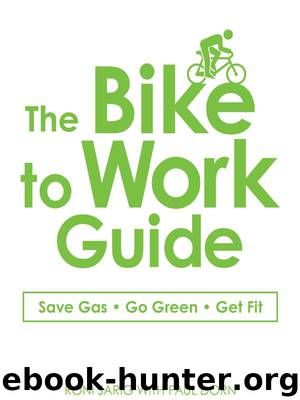The Bike to Work Guide by Roni Sarig & Paul Dorn

Author:Roni Sarig & Paul Dorn
Language: eng
Format: epub
Tags: ebook, book
Publisher: Adams Media, an F+W Media Company
Published: 2009-07-15T00:00:00+00:00
THE BEST FOODS FOR CYCLISTS
• Fresh fruits and vegetables
• Pasta and noodles
• Whole-grain breads
• Cereals
• Rice
• Tofu, soy products
• Low-fat meat, chicken, and fish
• Peanut butter
• Potatoes
• Nuts and legumes
FOODS TO AVOID
• Fatty meats and poultry
• Fried foods
• Whole-milk products
• Egg yolks
• Saturated oils and shortening
• Sugary foods and snacks
INJURY PREVENTION
The more you ride the better chance you have of suffering discomfort from time to time. Though not usually serious, any discomfort may make riding painful or develop into a worse problem if ignored. Sometimes the ailment stems from a problem with your form or with the fit of your bike. Other times it’s just a matter of wear and tear on your body. In either case, there are usually remedies—either behavioral changes or treatments—that can cure your discomfort, or at least minimize it. Whenever an ailment continues or worsens over time, though, professional medical help should be sought.
BACK AND NECK
Back problems are very common in society in general, and particularly prevalent in cyclists. Most often, the problem is a matter of poor posture—not only while riding but also when sitting and standing. People often roll their backs, which puts undo stress on the spine and lower back muscles, rather than keeping backs straight or arched.
Posture problems are remedied, simply, with better posture. While riding, your back should be completely straight. Practice pushing your belly out and toward the top tube in order to achieve a flat back. Off the bike, provide support for your lower back by using cushions and pillows and by remembering to sit up straight.
Sometimes, backaches afflict new riders because they are using unfamiliar muscles. Riders with excessive fat around the waist may put extra strain on their backs while cycling. On long rides, even trained riders can feel back discomfort from many hours of leaning forward. These pains should go away as lower back muscles are developed. Stretching and exercising both back and abdominal muscles will help speed the process; so will making sure your back stays warm while riding.
Often, improper positioning or bike fit can strain your back. Consider temporarily raising your handlebars to make it easier to straighten your back. For chronic back pain, consider switching to a recumbent bike.
Neck problems can also result from improper body position or a bike fit that makes you cramped. It can often be prevented by alternating your position regularly between upright, drop position, and out-of-the-saddle riding. If your bike has been properly fitted to your body, the most adjusting your bike should need is to slide the saddle back, raise the handlebars, or get a longer stem. Proper stretching and exercises will help strengthen neck muscles as well.
Ice packs, heat treatments, and light massage can help reduce pain and inflammation in the back and neck. Medications such as painkillers, muscle relaxants, and anti-inflammatory drugs can help as well. You may need a doctor’s prescription for more powerful medications.
KNEES
The knee is a large, complex—and not particularly strong—joint, giving the dedicated cyclist plenty of opportunities for injury. Four
Download
This site does not store any files on its server. We only index and link to content provided by other sites. Please contact the content providers to delete copyright contents if any and email us, we'll remove relevant links or contents immediately.
Shoe Dog by Phil Knight(4902)
The Rules Do Not Apply by Ariel Levy(4536)
Walking by Henry David Thoreau(3693)
Running Barefoot by Amy Harmon(3338)
I'll Give You the Sun by Jandy Nelson(3275)
How to Read Water: Clues and Patterns from Puddles to the Sea (Natural Navigation) by Tristan Gooley(3249)
Crazy Is My Superpower by A.J. Mendez Brooks(3210)
How to Read Nature by Tristan Gooley(3089)
How Music Works by David Byrne(2969)
The Boy, the Mole, the Fox and the Horse by Charlie Mackesy(2833)
The Fight by Norman Mailer(2710)
Seducing Cinderella by Gina L. Maxwell(2547)
Cuba by Lonely Planet(2491)
Accepted by Pat Patterson(2221)
Going Long by Editors of Runner's World(2217)
The Unfettered Mind: Writings from a Zen Master to a Master Swordsman by Takuan Soho(2161)
The Happy Runner by David Roche(2128)
Backpacker the Complete Guide to Backpacking by Backpacker Magazine(2112)
Trail Magic by Trevelyan Quest Edwards & Hazel Edwards(2064)
